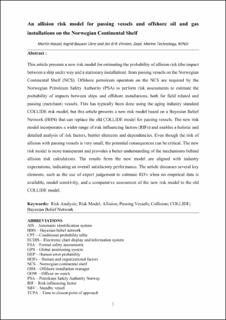| dc.contributor.author | Hassel, Martin | |
| dc.contributor.author | Utne, Ingrid Bouwer | |
| dc.contributor.author | Vinnem, Jan Erik | |
| dc.date.accessioned | 2021-01-11T09:25:42Z | |
| dc.date.available | 2021-01-11T09:25:42Z | |
| dc.date.created | 2020-10-02T10:10:30Z | |
| dc.date.issued | 2020 | |
| dc.identifier.citation | Proceedings of the Institution of Mechanical Engineers. Part O, Journal of risk and reliability. 2020, . | en_US |
| dc.identifier.issn | 1748-006X | |
| dc.identifier.uri | https://hdl.handle.net/11250/2722292 | |
| dc.description.abstract | This article presents a new risk model for estimating the probability of allision risk (the impact between a ship under way and a stationary installation) from passing vessels on the Norwegian Continental Shelf (NCS). Offshore petroleum operators on the NCS are required by the Norwegian Petroleum Safety Authority (PSA) to perform risk assessments to estimate the probability of impacts between ships and offshore installations, both for field related and passing (merchant) vessels. This has typically been done using the aging industry standard COLLIDE risk model, but this article presents a new risk model based on a Bayesian Belief Network (BBN) that can replace the old COLLIDE model for passing vessels. The new risk model incorporates a wider range of risk influencing factors (RIFs) and enables a holistic and detailed analysis of risk factors, barrier elements and dependencies. Even though the risk of allision with passing vessels is very small, the potential consequences can be critical. The new risk model is more transparent and provides a better understanding of the mechanisms behind allision risk calculations. The results from the new model are aligned with industry expectations, indicating an overall satisfactory performance. The article discusses several key elements, such as the use of expert judgement to estimate RIFs when no empirical data is available, model sensitivity, and a comparative assessment of the new risk model to the old COLLIDE model. | en_US |
| dc.language.iso | eng | en_US |
| dc.publisher | SAGE Publications | en_US |
| dc.rights | Attribution-NonCommercial-NoDerivatives 4.0 Internasjonal | * |
| dc.rights.uri | http://creativecommons.org/licenses/by-nc-nd/4.0/deed.no | * |
| dc.title | An allision risk model for passing vessels and offshore oil and gas installations on the Norwegian Continental Shelf | en_US |
| dc.type | Peer reviewed | en_US |
| dc.type | Journal article | en_US |
| dc.description.version | acceptedVersion | en_US |
| dc.source.pagenumber | 16 | en_US |
| dc.source.journal | Proceedings of the Institution of Mechanical Engineers. Part O, Journal of risk and reliability | en_US |
| dc.identifier.doi | 10.1177/1748006X20957481 | |
| dc.identifier.cristin | 1836484 | |
| dc.description.localcode | © 2020. This is the authors' accepted and refereed manuscript to the article. This manuscript version is made available under the CC-BY-NC-ND 4.0 license http://creativecommons.org/licenses/by-nc-nd/4.0/ The final authenticated version is available online at: http://dx.doi.org/10.1177/1748006X20957481 | en_US |
| cristin.ispublished | true | |
| cristin.fulltext | postprint | |
| cristin.qualitycode | 1 | |

